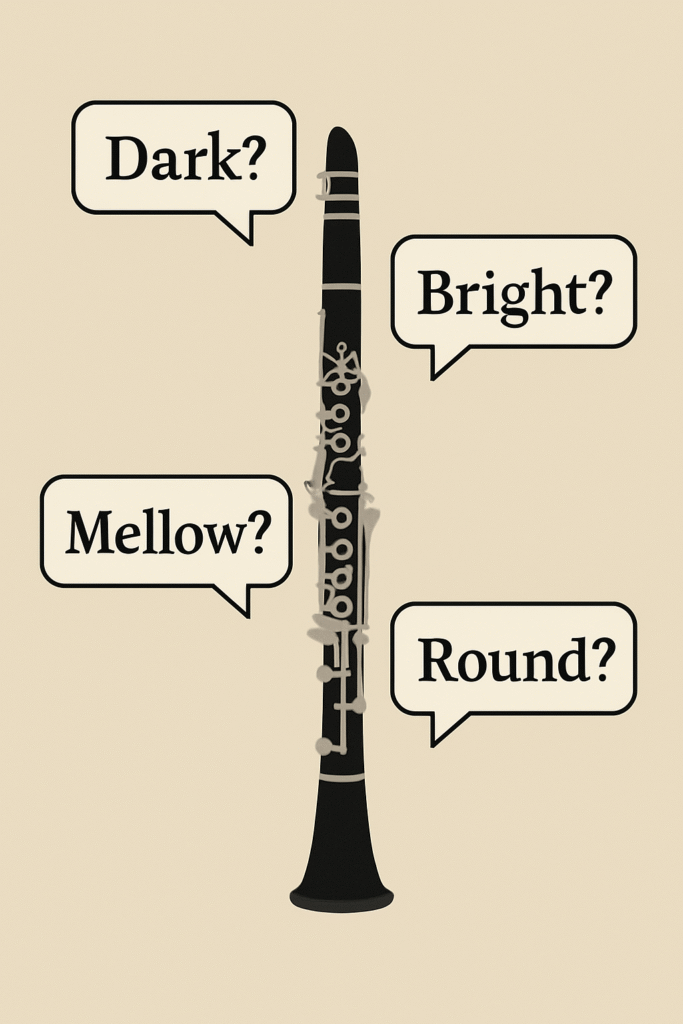
Picking a Clarinet: Why It’s More Subjective Than You Think
Choosing a clarinet isn’t about finding the one that’s objectively “best.” It’s about finding the one that feels right to you. There are measurable design differences between clarinets, such as materials, bore size, and tone hole placement; but how those differences translate into sound and response is personal. Two players can test the same clarinet and describe it in completely different ways, and both can be right!
Understanding the Language of Sound
When we talk about clarinets, we naturally reach for words to describe how they play: warm, dark, bright, resistant, open. Some players think in terms of shape—round, focused, spread, thin—while others talk about tone color or texture, such as bright, dark, or resonant. But these words describe sensations, not facts. What feels “resistant” to one player might feel “stable” to another. “Open” might mean that the tone is flexible to some, but has a lack of focus to others. Because our vocabulary for sound is rooted in personal experience, two players can describe the same clarinet in completely opposite ways. The clarinet hasn’t changed; our perception has. Still, developing your own language for what you hear and want to hear can be helpful. Whatever language helps you identify the sound you’re after can give you direction, but it’s important to remember that this language describes a subjective experience, not an objective truth.
So why do players hear the same clarinet differently? Because one of the biggest variables in tone is the player’s own mouth and embouchure. Add the mouthpiece to that equation, and the results shift even more.
It’s much like reed and mouthpiece pairing: a reed that’s too hard for an open mouthpiece–or too soft for a closed one–will completely change how it feels and sounds. In the same way, a clarinet may seem more or less resonant simply because of how it interacts with one’s current setup, not because of the instrument itself.
When you try new clarinets, you’re always gauging them against what you’re used to. That’s not a wrong thing to do, but it can limit what you perceive. Don’t be afraid to experiment! Try different reeds or mouthpieces, and if you’ve never really explored how your mouthpiece affects your sound, that’s a great place to start. Many players simply use what’s been recommended to them, without ever identifying what sound they actually want for themselves. Learning what specific mouthpiece traits create the sound you’re chasing can make a major difference when evaluating new instruments.
Your First Variable: Check Your Setup
Before judging a clarinet, make sure you’re playing on a balanced setup. An uneven reed or mismatched mouthpiece can completely alter how a clarinet feels. A clarinet that seems dull or unresponsive might come to life with a better reed or a mouthpiece that fits your playing style. Even a great mouthpiece on one clarinet may not pair as well with another. The relationship between mouthpiece and clarinet is delicate, so approach testing with flexibility.
Finding Balance Between Reed, Mouthpiece, and Clarinet
The same balance that exists between reed and mouthpiece also exists between mouthpiece and clarinet. When comparing a new instrument, start with your familiar setup but be willing to test different combinations.
A clarinet that first feels less vibrant may reveal more resonance with a different mouthpiece or reed cut. What we interpret as “less resonance” often comes from habit rather than true difference. Our perception of tone is shaped by what we’ve grown accustomed to.
The Takeaway
Choosing a clarinet is about partnership, not perfection. Learn the differences between models, take guidance where it’s helpful, and then listen for the sound you want to have. If you don’t yet know what that sound is, that’s your first task before you start picking equipment. Seek out recordings of clarinetists whose tone you want to emulate, and jot down some notes on what you like about their sound. Once you understand the sound you’re after, you’ll be able to find the clarinet and setup that truly match your voice. Be sure to check out our last blog post, “Give the Gift of Clarinet This Christmas Season”, for some equipment recommendations and considerations as you begin your journey!
– Jonathan Copeland
